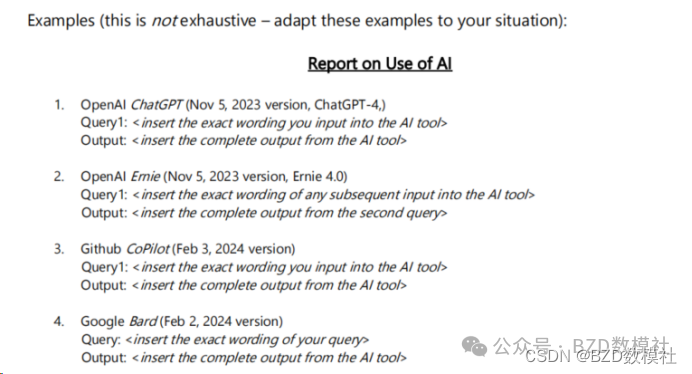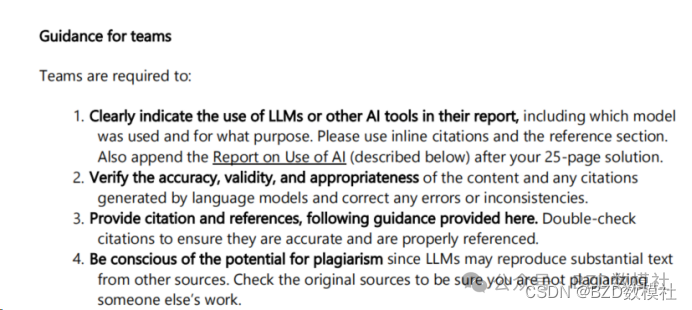Recently, some people have been sending private messages asking about the application of AI to mathematical models. This time I would like to use the instructions for the use of AI tools in the 2024 US competition and the results of last year’s national competition meeting to share with you the attitudes of the national competition and the US competition towards AI and how to use AI in digital modeling. This article will explain based on three AI tools that I commonly use ( Chat GPT , Wen Xinyiyan , NEW bing )
According to the original words of Mr. Xie Jinxing of the organizing committee at the 2023 National Competition Summary and Exchange Meeting, the National Competition’s attitude toward AI is neither boycott nor encouragement. AI detection tools will not be introduced in the national competition in the next two years for testing. According to the results of the use of large language models and generative artificial intelligence tool files in the COMAP competition in 2024, the attitude of the US competition towards AI is neither resisting nor encouraging. But the usage process needs to be clear. Give a report on the use of AI in the paper, Report on Use of AI.
Since the US competition is approaching, here is a detailed explanation of the documents related to the AI tool usage rules newly released by US competition this year. This document mainly has three important points. 1. Report on Use of AI is the only value in this competition that can be written beyond the 25 pages of content. 2. The four items that teams need to know will be explained in detail later. 3. Report on Use of AI format specifications.
Citations and references are noted in the text, making it clear that after the report is over, please add a new section titled "AI Usage Report." This new section has no page limit and will not count as part of the 25-page solution. This is the new Report on Use of AI added to this competition

In order to prevent everyone from casually writing AI usage reports, sample specifications are also given in the document, as shown in the figure below 
A rough translation of the content is as follows:
Example (this is not the full example, please adapt it to your situation):
AI usage report
OpenAI ChatGPT (November 5, 2023 version, ChatGPT-4)
Query 1: <insert the exact wording you entered into the AI tool>
Output: <insert complete output of AI tool>
OpenAI Ernie (version November 5, 2023, Ernie 4.0)
Query 1: <insert any wording you subsequently enter into the AI tool>
Output: <insert full output of second query>
Github CoPilot (version February 3, 2024)
Query 1: <insert the exact wording you entered into the AI tool>
Output: <insert complete output of AI tool>
Google Bard (version February 2, 2024)
Query: <insert the exact wording of your query>
Output: <insert complete output of AI tool>
Finally, the most important point is that in the document, Mesai has given four requirements, and each of them should be strictly followed. Let me explain this document in detail below.

The first point is to clearly mark the use of AI tools :
It is required that results from AI tools be explicitly mentioned using inline citations and noted in the references section. That is to say, in addition to the literature appearing in the article, the places where AI is used must also be marked and explained. The specific labels should be the same as those in Report on Use of AI. As for marking references, we use symbols such as [1], [2], [3]... to mark references. I personally think that Mesai’s new tags should not be the same as [1], [2], [3], etc., but should be directly marked using data such as 1, 2, 3, etc. This label is the label of Report on Use of AI.
Second point, verify the accuracy, validity and appropriateness of the content
Regarding this point, I think it needs to be stated in the article or in the Report on Use of AI, how we verified the accuracy. The current preliminary opinion here is that we have made a human judgment on the results output by the AI, the results are correct, etc., and conducted appropriate qualitative analysis.
Point 3: Provide citations and references
This also echoes the second point. To verify the accuracy, validity and appropriateness of the content. We need to give the specific source document of the content, which should be displayed in the references. The best part of this part is new bing, which can directly give the source. For Wenxinyiyan and ChatGPT, certain instructions are required to obtain them.
Point 4: Pay attention to avoid plagiarism
For the fourth point, I personally think that a good way is to check all AI results for plagiarism and attach the results to the Report on Use of AI to verify our correctness.
In order to better help you use AI in digital analog, I recorded a series of videos at Station B to explain the application of AI in modeling, programming, and paper writing. You can listen to it. Below is the course syllabus.
